The Euro-Mediterranean Partnership Ten Years On: Reassessing Readiness and Prospects, Statement by Saleh M. Nsouli, Director of IMF Offices in Europe, IMF
June 23, 2006
Director, IMF Offices in Europe1
International Monetary Fund
At Crans-Montana Forum, Monaco
June 23, 2006
It is a great pleasure for me to be able to participate in this discussion today about the European Union (EU) and the Mediterranean. Not only does the topic overlap with my current duties, but during my career in the IMF I have worked on many of the Southern Mediterranean countries. Moreover, ten years ago, I wrote, with two IMF colleagues, a paper on the potential benefits and costs of the Euro-Mediterranean Partnership (EMP), which had then just been launched.2 Against the background of that paper, I would like to focus my presentation on the experience to date with the EMP, on its prospects, and on how the European Neighbourhood Policy, initiated in 2004, furthers the Partnership. In this context, I would like to underscore that the work of the Fund in supporting progress toward macroeconomic stability and structural reforms to reduce distortions, including the liberalization of trade, contributes to the move of these countries toward key economic objectives of the EMP.
I will seek to address the following questions:
• What were the original objectives of the Euro-Mediterranean Partnership (EMP)?
• What were the starting conditions and what did we see as the preconditions for success?
• Where are we ten years later?
• Why has more progress not been made?
• How does the European Neighbourhood Policy address the problems that arose?
• What can be concluded about the outlook for the EMP now?
1. What were the objectives of the EMP?
The EMP, also referred to as the Barcelona Process, was launched at a Euro-Mediterranean Foreign Ministers meeting in Barcelona in November 1995, although it built on a long period of EU cooperation with and assistance to the Union's Mediterranean neighbors, going back to the 1970s. The aims of the EMP extend well beyond economics, with broad goals including political stability, strengthening cultural ties, and protecting the environment. I will here consider only the economic component of the EMP, the main objective of which was "the construction of a zone of shared prosperity."3
The Barcelona Declaration set out a number of elements as being involved in the creation of such a zone of shared prosperity:
• the acceleration of the pace of sustainable socio-economic development in the Euro-Mediterranean countries;
• the improvement of the living conditions of their populations, the increase in the employment level and the reduction in the development gap in the Euro-Mediterranean region; and
• the encouragement of regional cooperation and integration.
In order to achieve these objectives, intermediate goals were also set. The Barcelona Declaration called for "an economic and financial partnership" based on:
• the progressive establishment of a free-trade area (covering "most trade") by 2010;
• the implementation of appropriate economic cooperation and concerted action in a number of areas, including fishing, energy, water, and agriculture;
• a substantial increase in the EU's financial assistance to its partners. ECU 4.7 billion in assistance from Community budget funds was planned for the period 1995-1999, supplemented by additional European Investment Bank (EIB) loans.
The key instrument seen as furthering the objectives of development and integration in the region was, therefore, trade liberalization, supported by increased aid.
2. What were the starting conditions and what did we see as the preconditions for success?
When my colleagues and I looked at the new EMP in 1996, we acknowledged the potential significance of the gains from freeing trade among the partner countries. We noted, however, that the size of the net gains would be limited to the extent that free trade was restricted to industrial products, where Euro-Mediterranean countries already enjoyed preferential access to the EU market, and to the extent that bilateral free trade agreements with the EU created a hub-spoke effect, encouraging investment in the EU rather than the partner countries, in order to get access to the whole regional market.
We also predicted that "success... will depend on the ability of [Mediterranean] countries to meet a wide range of preconditions." 4 We identified six preconditions associated with maximizing a country's ability to reap the benefits arising from freer trade and/or minimizing the associated adjustment costs.
First, macroeconomic stability was needed to deal effectively with the real depreciation of a country's currency implied by the lowering of import barriers, and to establish the credibility to attract foreign investors. Low and stable inflation, sustainable public finances, and a viable balance of payments position are essential to supporting and reaping the benefits from trade openness.
Second, a low reliance on trade taxes meant less pressure on the budget arising from trade liberalization, and less effort required to adjust the structure of revenues toward domestic taxes.
Third, a low level of external debt gave confidence to potential investors that the probability of a balance of payments or debt crisis was low and tax hikes were not on the way.
Fourth, a high initial level of openness to trade suggested less of a need for structural adjustment after an entry into a free-trade area.
Fifth, a liberal regulatory framework facilitated the efficient reallocation of resources that would result from trade liberalization.
Finally, a comprehensive social safety net would minimize transition costs and protect vulnerable groups.
We concluded ten years ago that "considerable adjustment and reform efforts are needed in all [Euro-Mediterranean partner] countries, although to varying degrees." As can be seen from Table 1, none of the countries had favorable conditions across all the areas for which quantitative indicators were readily available then. And while it was difficult to quantify the degree of liberalization of the regulatory framework or the provision of social safety nets, we concluded that most Euro-Mediterranean countries had much to do in these areas also.
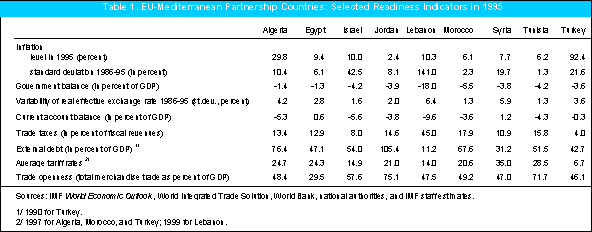 |
3. Where are we 10 years later?
The first decade of the EMP has seen a mixed record, both as regards the ultimate economic aims of the partnership and the intermediate steps.
There have certainly been some positive developments:
• Some progress on trade liberalization was made. All but one of the Euro-Mediterranean countries have signed association agreements with the EU providing for the gradual elimination of industrial tariffs and the removal of non-tariff barriers.5,6 Moreover, a few trade agreements between Mediterranean countries have also been reached, notably the 2004 Agadir Agreement between Morocco, Tunisia, Jordan, and Egypt.7 In addition, work on harmonizing customs procedures and improving rules for determination of origin has borne some fruit.
• Financial support was stepped up. Although the initial quantitative financial support objective for 1995-99 specified in the Barcelona Declaration was not met, there has nonetheless been a significant increase in financial assistance from the EU to its Euro-Mediterranean partners (see Chart 1). In addition to the MEDA and MEDA II development assistance programs, which were specifically established for the EMP, the European Investment Bank (EIB) has also greatly increased its lending to the region, and in 2002 it brought together its lending operations to the EMP countries in a new Facility for Euro-Mediterranean Investment and Partnership (FEMIP), which has seen a further rise in EIB commitments to the region.
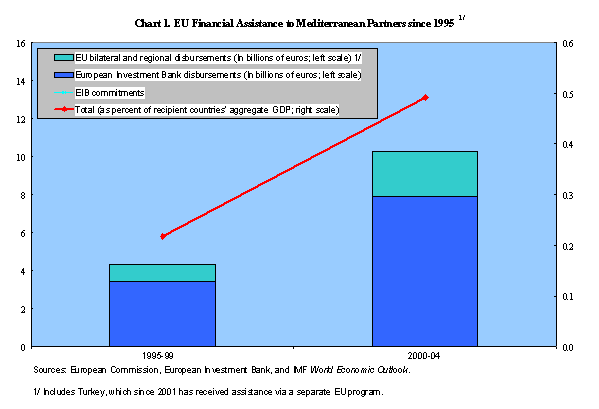 |
• Two of the original EMP countries (Cyprus and Malta) subsequently became EU members, and one (Turkey) became a candidate for accession.
• Macroeconomic stability has improved in most Euro-Mediterranean countries. As can be seen from Chart 2, the evolution of inflation, fiscal balances, current account balances, real per capita GDP growth, and real effective exchange rate variability all show the positive developments. While it is debatable whether or not these improvements resulted to any significant degree from the EMP, they increased the chances of the partner countries reaping greater benefits from the partnership.
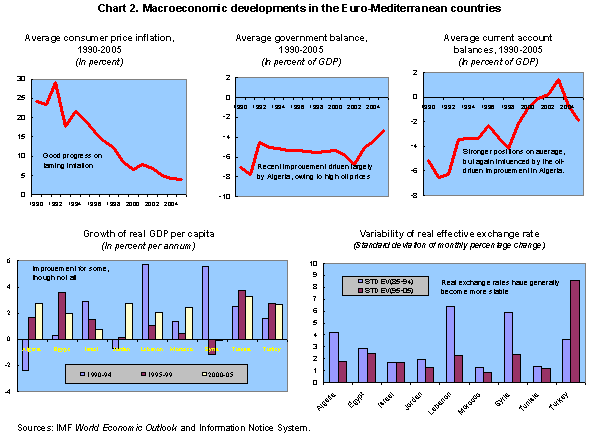 |
• Social indicators in general improved, though again not necessarily as a result of the Barcelona Process. Indicators showing improvement in most countries included life expectancy, infant mortality, and literacy (Table 2).
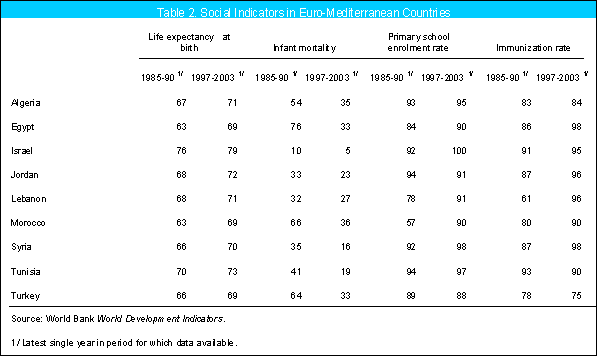 |
Alongside these positive developments, however, there have also been some less favorable ones. In particular:
• Overall, living standards in Euro-Mediterranean countries have failed to converge towards EU levels. On average, and most of the partner countries, GDP per capita adjusted for purchasing power parity has actually declined relative to the EU since 1995 (Chart 3).
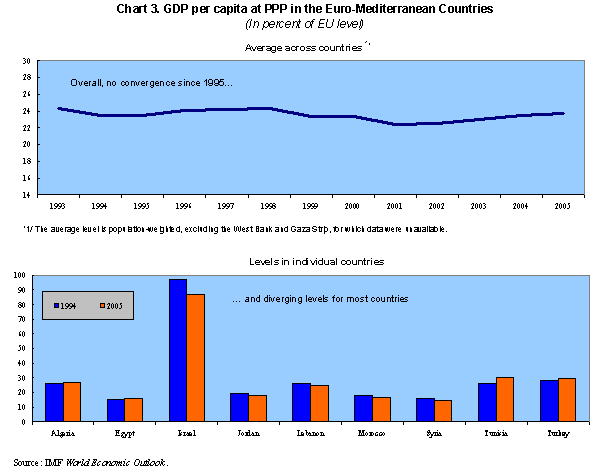 |
• Employment growth in the region has failed to keep pace with increases in the labor force, despite an improvement in the last couple of years, with unemployment, particularly youth unemployment, remaining a serious problem (Chart 4).
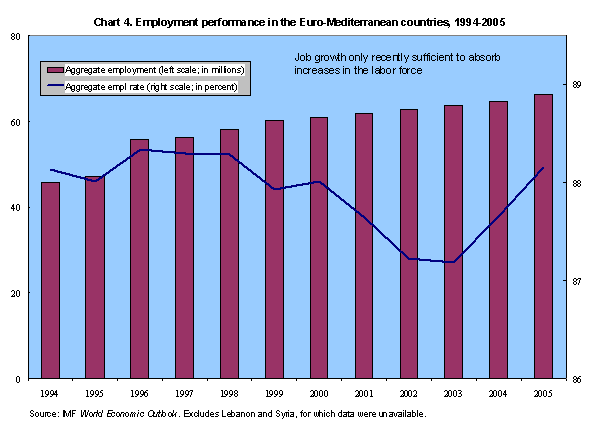 |
• Euro-Mediterranean trade integration has been limited. It has taken a long time for some of the EMP countries to sign association agreements and set in motion the process of trade liberalization (Table 3).
|
Table 3. Euro-Mediterranean Association Agreements | |||||
Euro-Mediterranean Partner |
Signed |
In force as from | |||
Algeria |
April 22, 2002 |
In process of ratification | |||
Egypt |
June 25, 2001 |
June 1, 2004 | |||
Israel |
November 20, 1995 |
June 1, 2000 | |||
Jordan |
November 24, 1997 |
May 1, 2002 | |||
Lebanon |
June 17, 2002 |
In process of ratification | |||
Morocco |
February 26, 1996 |
March 1, 2000 | |||
Palestinian Authority |
February 24, 1997 |
July 1, 1997 | |||
Syria 1 |
Initialed October 19, 2004 |
||||
Tunisia |
July 17, 1995 |
March 1, 1998 | |||
Turkey 2 |
June 3, 1995 |
December 31, 1995 | |||
|
Source: European Commission. | |||||
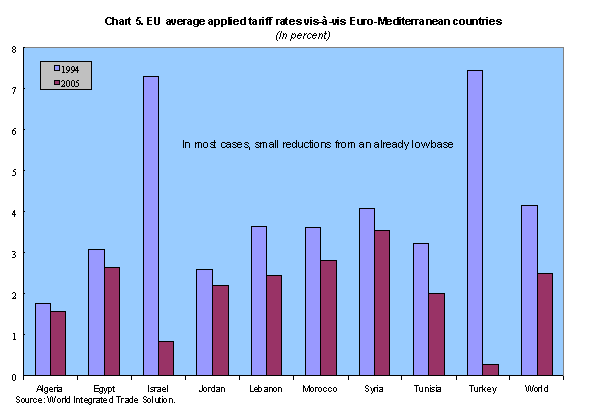 |
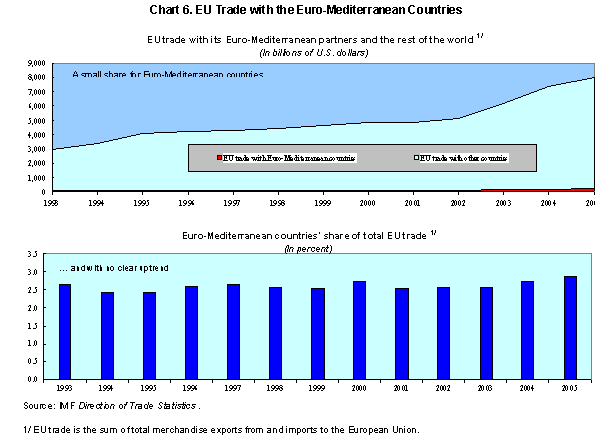 |
• There has been little South-South regional integration (Chart 7), so that the EMP has mainly had a hub-and-spoke character. It is notable, in that regard, that the Agadir agreement, while a welcome development and a positive model for further liberalization among the Mediterranean countries, has yet to be ratified.
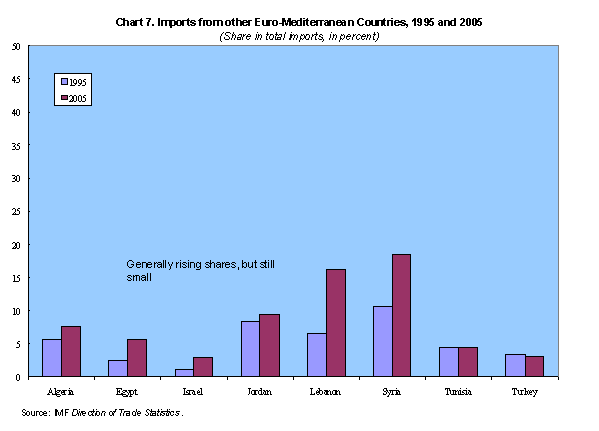 |
• The increase in inward foreign direct investment (FDI) has been slower than hoped, with inflows from the EU fluctuating but declining as a share of total EU outward FDI (Chart 8).
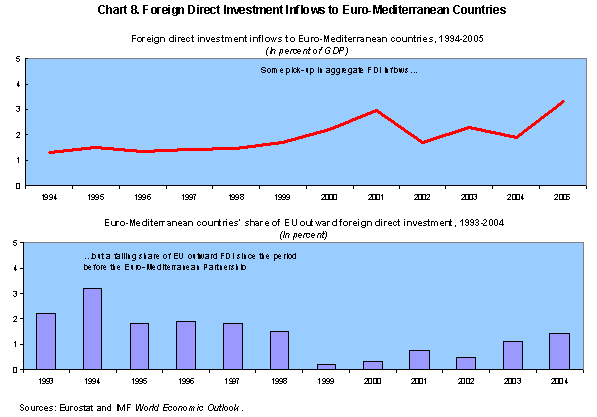 |
• There has been little progress on "behind the border" structural reforms. Although progress has been made in a number of cases, Euro-Mediterranean countries, on average, are generally considered to be still relatively inflexible and overregulated (Table 4), and in need of educational and labor market reforms to contribute to more rapid productivity growth.
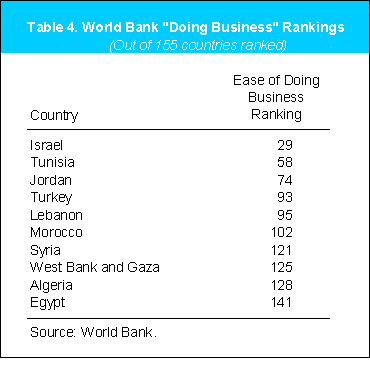 |
4. Why has more progress not been made?
The limited progress in the first decade of the EMP in expanding trade, fostering investment in the region, and accelerating the convergence in living standards has four key explanatory factors.
First, the slowness in moving ahead with association agreements, and the inclusion of long transition periods before trade liberalization bites on Euro-Mediterranean partner countries, may partly have reflected the fact that, as we concluded in 1996, some countries were not ready to take full advantage of the partnership. With some combination of unstable macroeconomic conditions, high external debt, heavy reliance on trade taxes, low initial trade openness, excessive regulation, and weak social safety nets, some partner countries may not have perceived strong gains from rapidly pursuing free trade with the EU, and even less from liberalizing trade within the region.
Second, the degree of economic integration with the EU that was initially on offer under the EMP was rather limited. The main instrument was free trade, but even in this area there was no timetable to liberalize trade in agriculture or fisheries, which are important sectors in many of the Euro-Mediterranean countries, and services trade was not initially included. Still less was deeper economic integration, such as the free movement of labor, provided for in the Barcelona Declaration.
Third, there was no explicit mechanism within the Barcelona Process to motivate structural reform in partner countries. The EMP's main economic goal, the establishment of a free trade area by 2010, was the same for all countries. There was no strong incentive in the partnership, even for countries that would have been able to move quickly or to achieve a greater degree of economic integration, to do so.
Third, in some cases exogenous conditions were unfavorable for at least some of the period since the launching of the EMP. For example, during the past decade a number of Mediterranean partner countries have experienced conflict situations, which made it harder to establish macroeconomic stability and pursue structural reforms.
5. How does the European Neighbourhood Policy address the problems that arose?
In 2004, a new European Neighbourhood Policy (NP) was launched.8 The Neighbourhood Policy, which applies also to non-Mediterranean neighbors of the EU, was intended to complement rather than to replace the Barcelona Process for the Euro-Mediterranean countries. In particular, via its national action plans, which are negotiated with the EU, the NP provides a bilateral mechanism to leverage accelerated structural reforms and offers additional rewards in the form of closer integration into the EU single market. By adopting common technical norms and standards, rules for protecting intellectual property rights, competition and consumer protection regulation and so on, European Neighbourhood countries can choose to participate in those areas of the EU internal market that most interest them.
Some studies have suggested that the sort of enhanced integration, or "deep free trade", offered by the NP yields potential gains that are much greater than those possible via the removal of tariffs alone.9 This may help address the possible problem of weak incentives to move forward with trade liberalization and associated reforms that seems to have affected the EMP to date.
Also, the "positive conditionality" aspect of the national action plans, whereby more integration is offered in return for more market reform, addresses the lack of mechanisms under the Barcelona Process to reward more ambitious reform.
One limitation that appears to remain with the combination of the EMP and the NP is that it remains unclear how a satisfactory pace of South-South integration can be ensured. This leaves the risk that economic integration will continue to have mainly a hub-and-spoke character, which both increases losses associated with trade diversion and saps incentives to make direct investments in Euro-Mediterranean countries in order to serve the regional market. Indeed, to the extent that political and administrative energy goes into the NP process rather than the EMP, there must be some risk that the regional dimension would diminish in coming years. That remains to be seen, however.
6. What can be concluded about the outlook for the EMP now?
As we have seen, Euro-Mediterranean countries have been in some cases slow to sign association agreements and move towards free trade with the EU. They have tended to be even more hesitant to conclude free trade agreements with other Euro-Mediterranean countries. Part of the explanation for this reticence may, as noted earlier, be found in these countries' perception that the net gains from freer trade with the EU and other countries in the region were limited, given in part their lack of economic readiness to benefit much from greater market access. As can be seen from Table 5, however, the quantitative readiness indicators that we considered a decade ago are generally more favorable now than they were then. Other things being equal, this raises the potential net gains from freer trade for these countries, and gives them more incentive to complete the free trade area that was envisioned in 1995.
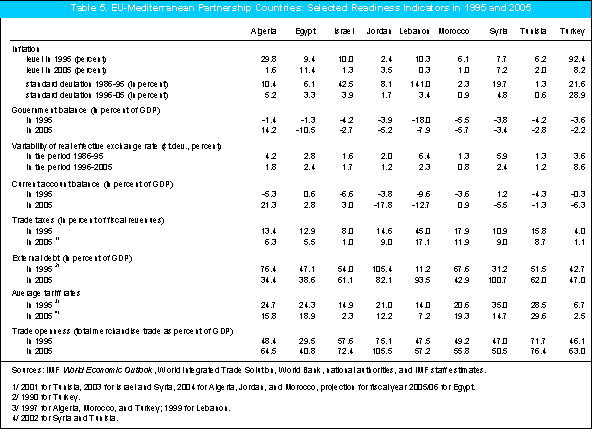 |
Meanwhile, the relatively recent European Neighbourhood Policy provides a new mechanism to leverage domestic structural reforms in Euro-Mediterranean countries. An acceleration of such reforms would put these countries in a better position to benefit from the trade liberalization and deeper economic integration that is now on offer from the EU. As against this, the administrative and political challenges of conforming with parts of the EU's acquis communautaire in order to benefit from integration into the single market are considerable for these countries, raising questions as to how quickly they will be able to progress. If the payoffs, albeit potentially large, seem too distant and uncertain, the incentive to implement difficult reforms now will be weakened.
Another factor bearing on partner country incentives is the EU's willingness to negotiate trade integration going beyond the original goals of the Barcelona Declaration. In November 2005 the Council authorized negotiations with the EU's Mediterranean partners on the liberalization of services and investment, and such negotiations were launched with seven Mediterranean partners at the March meeting of trade ministers in Marrakech. Economic models suggest that the potential gains from services liberalization would be even greater than the removal of tariffs on merchandise imports. Moreover, the 5 year work program approved by Euro-Mediterranean foreign ministers in November 2005 calls for negotiations on progressive liberalization in agriculture and fisheries. As these are the areas where goods trade remains the most restrictive, the gains from liberalization are potentially large.
As noted earlier, another lacuna in the track record under the EMP so far has been the lack of progress on South-South integration. The conclusion of a number of bilateral South-South agreements, and in particular the quadrilateral Agadir Agreement in 2004, raise hopes that momentum is building in this area, although it remains the case that there is no mechanism under either the EMP or the NP to encourage such agreements. The EU has, however, sought to strengthen the incentives for South-South trade integration. For example, by an October 2005 decision of the European Council the system of cumulation of origin was extended to Mediterranean countries, permitting goods processed in one or more countries to benefit from the same preferential access to the EU market as goods exported directly from the country of origin, provided that the countries involved have a free trade agreement in place. This constitutes a new inducement for the Euro-Mediterranean countries to conclude free trade agreements among themselves, and at the Marrakech trade ministers' meeting in March 2006 they reaffirmed their willingness to do so.
All in all, the prospects for achieving a Euro-Mediterranean free trade area and delivering a zone of shared prosperity, with convergence of living standards towards EU levels, look better now than they did ten years ago. The integration goals (both via the Barcelona Process and the Neigbourhood Policy) are now more ambitious, increasing the potential gains for partner countries, and there is an additional instrument, namely the national action plans under the Neighbourhood Policy, to motivate domestic policy reforms.
However, even if the incentives to reform and liberalize are now stronger for the Euro-Mediterranean countries under the EMP and the Neighbourhood Policy than they were at the outset of the Barcelona Process, there remains a question of whether they are strong enough. The experience with the countries that have acceded to EU membership or are on track to do so suggests that accession is a uniquely powerful tool to leverage reform and convergence. As accession is not on offer either in the Barcelona Process or the European Neighbourhood Policy, it is natural to question whether the sorts of rapid transformation of economies and strong productivity growth achieved in Eastern and Southern European accession countries can be replicated in the Mediterranean region.
As I indicated at the outset, the IMF has, by virtue of its mandate to foster macroeconomic stability and facilitate the balanced expansion of trade, a shared interest in encouraging structural reform, encouraging prudent macroeconomic policies, and advocating the removal of barriers to trade in the EU's Mediterranean neighbors. Thus, for example, during a visit last year to the Maghreb countries, the Managing Director of the IMF proposed to the authorities to hold a conference on trade facilitation in the region. At that conference, which took place in Algiers in November 2005, he recognized that the Maghreb countries' growing economic integration with the EU had already borne fruit, but called for greater intra-regional economic integration as a means to improve economic efficiency, attract more foreign investors, and create opportunities for mutually beneficial trade within the region.10 This is very much in keeping with the objectives of the Barcelona Process. Also, in an article a year ago in the Moroccan newspaper L'Economiste, our Managing Director acknowledged the potential for economic integration with the EU spurring necessary domestic economic reforms in the Maghreb countries, and noted that the Fund could assist them in implementing the European Neighbourhood Policy.11 More broadly, via our regular surveillance and technical assistance activities in the Euro-Mediterranean countries, as well as, if needed, balance of payments assistance in the context of Fund-supported programs, the IMF's work will continue to contribute to furthering the key economic objectives of the Barcelona Process.
1 The views expressed in this presentation are those of the author and should not be attributed to the International Monetary Fund, its Executive Board, or its management. I am grateful to Geoff Barnard for his help in preparing this note, and to several colleagues for their suggestions.
2 The paper is summarized in Saleh M. Nsouli, Amer Bisat, and Oussama Kanaan, "The European Union's New Mediterranean Strategy", Finance & Development, September, 1996, IMF, Washington DC.
3 Barcelona Declaration, adopted at the Euro-Mediterranean Conference, November 27-28 1995. See http://ec.europa.eu/comm/external_relations/euromed/bd.htm.
4 Nsouli, Bisat, and Kanaan (above).
5 Turkey has gone further than the other Mediterranean countries by establishing in 1995 a customs union with the EU, but this was the culmination of a process that had begun in the 1960s and pre-dated the EMP.
6 The association agreement with Syria has been initialed but not signed.
7 Turkey also has bilateral trade agreements with Egypt, Morocco, and Tunisia, and there is a bilateral agreement between Israel and Jordan.
8 The new policy was first outlined in an EC Communication in March 2003, but was only fleshed out and made operational in 2004.
9 For example, Michael Emerson et al., The Prospect for Deep Free Trade between the European Union and Ukraine, Centre for European Policy Studies, March 2006; and Malgorzata Jakubiak et al., Countries Bordering the EU and Enhanced Economic Integration, Center for Social and Economic Research, March 2006.
10 "Introductory Remarks by Rodrigo de Rato, Managing Director of the International Monetary Fund" at the Conference on Trade Facilitation in Algeria, Morocco, and Tunisia, Algiers, Algeria, November 21, 2005. See http://www.imf.org/external/np/speeches/2005/112105.htm.
11 "Economic Integration in the Maghreb: the Path to Prosperity: A Commentary", by Rodrigo de Rato, Managing Director, International Monetary Fund. See http://www.imf.org/external/np/vc/2005/061505.htm.
|
1. What were the objectives of the EMP? The EMP, also referred to as the Barcelona Process, was launched at a Euro-Mediterranean Foreign Ministers meeting in Barcelona in November 1995, although it built on a long period of EU cooperation with and assistance to the Union's Mediterranean neighbors, going back to the 1970s. The aims of the EMP extend well beyond economics, with broad goals including political stability, strengthening cultural ties, and protecting the environment. I will here consider only the economic component of the EMP, the main objective of which was "the construction of a zone of shared prosperity."3 The Barcelona Declaration set out a number of elements as being involved in the creation of such a zone of shared prosperity: • the acceleration of the pace of sustainable socio-economic development in the Euro-Mediterranean countries; • the improvement of the living conditions of their populations, the increase in the employment level and the reduction in the development gap in the Euro-Mediterranean region; and • the encouragement of regional cooperation and integration. In order to achieve these objectives, intermediate goals were also set. The Barcelona Declaration called for "an economic and financial partnership" based on: • the progressive establishment of a free-trade area (covering "most trade") by 2010; • the implementation of appropriate economic cooperation and concerted action in a number of areas, including fishing, energy, water, and agriculture; • a substantial increase in the EU's financial assistance to its partners. ECU 4.7 billion in assistance from Community budget funds was planned for the period 1995-1999, supplemented by additional European Investment Bank (EIB) loans. The key instrument seen as furthering the objectives of development and integration in the region was, therefore, trade liberalization, supported by increased aid. 2. What were the starting conditions and what did we see as the preconditions for success? When my colleagues and I looked at the new EMP in 1996, we acknowledged the potential significance of the gains from freeing trade among the partner countries. We noted, however, that the size of the net gains would be limited to the extent that free trade was restricted to industrial products, where Euro-Mediterranean countries already enjoyed preferential access to the EU market, and to the extent that bilateral free trade agreements with the EU created a hub-spoke effect, encouraging investment in the EU rather than the partner countries, in order to get access to the whole regional market. We also predicted that "success... will depend on the ability of [Mediterranean] countries to meet a wide range of preconditions." 4 We identified six preconditions associated with maximizing a country's ability to reap the benefits arising from freer trade and/or minimizing the associated adjustment costs. First, macroeconomic stability was needed to deal effectively with the real depreciation of a country's currency implied by the lowering of import barriers, and to establish the credibility to attract foreign investors. Low and stable inflation, sustainable public finances, and a viable balance of payments position are essential to supporting and reaping the benefits from trade openness. Second, a low reliance on trade taxes meant less pressure on the budget arising from trade liberalization, and less effort required to adjust the structure of revenues toward domestic taxes. Third, a low level of external debt gave confidence to potential investors that the probability of a balance of payments or debt crisis was low and tax hikes were not on the way. Fourth, a high initial level of openness to trade suggested less of a need for structural adjustment after an entry into a free-trade area. Fifth, a liberal regulatory framework facilitated the efficient reallocation of resources that would result from trade liberalization. Finally, a comprehensive social safety net would minimize transition costs and protect vulnerable groups. We concluded ten years ago that "considerable adjustment and reform efforts are needed in all [Euro-Mediterranean partner] countries, although to varying degrees." As can be seen from Table 1, none of the countries had favorable conditions across all the areas for which quantitative indicators were readily available then. And while it was difficult to quantify the degree of liberalization of the regulatory framework or the provision of social safety nets, we concluded that most Euro-Mediterranean countries had much to do in these areas also.
3. Where are we 10 years later? The first decade of the EMP has seen a mixed record, both as regards the ultimate economic aims of the partnership and the intermediate steps. There have certainly been some positive developments: • Some progress on trade liberalization was made. All but one of the Euro-Mediterranean countries have signed association agreements with the EU providing for the gradual elimination of industrial tariffs and the removal of non-tariff barriers.5,6 Moreover, a few trade agreements between Mediterranean countries have also been reached, notably the 2004 Agadir Agreement between Morocco, Tunisia, Jordan, and Egypt.7 In addition, work on harmonizing customs procedures and improving rules for determination of origin has borne some fruit. • Financial support was stepped up. Although the initial quantitative financial support objective for 1995-99 specified in the Barcelona Declaration was not met, there has nonetheless been a significant increase in financial assistance from the EU to its Euro-Mediterranean partners (see Chart 1). In addition to the MEDA and MEDA II development assistance programs, which were specifically established for the EMP, the European Investment Bank (EIB) has also greatly increased its lending to the region, and in 2002 it brought together its lending operations to the EMP countries in a new Facility for Euro-Mediterranean Investment and Partnership (FEMIP), which has seen a further rise in EIB commitments to the region.
• Two of the original EMP countries (Cyprus and Malta) subsequently became EU members, and one (Turkey) became a candidate for accession. • Macroeconomic stability has improved in most Euro-Mediterranean countries. As can be seen from Chart 2, the evolution of inflation, fiscal balances, current account balances, real per capita GDP growth, and real effective exchange rate variability all show the positive developments. While it is debatable whether or not these improvements resulted to any significant degree from the EMP, they increased the chances of the partner countries reaping greater benefits from the partnership.
• Social indicators in general improved, though again not necessarily as a result of the Barcelona Process. Indicators showing improvement in most countries included life expectancy, infant mortality, and literacy (Table 2).
Alongside these positive developments, however, there have also been some less favorable ones. In particular: • Overall, living standards in Euro-Mediterranean countries have failed to converge towards EU levels. On average, and most of the partner countries, GDP per capita adjusted for purchasing power parity has actually declined relative to the EU since 1995 (Chart 3).
• Employment growth in the region has failed to keep pace with increases in the labor force, despite an improvement in the last couple of years, with unemployment, particularly youth unemployment, remaining a serious problem (Chart 4).
• Euro-Mediterranean trade integration has been limited. It has taken a long time for some of the EMP countries to sign association agreements and set in motion the process of trade liberalization (Table 3).
• There has been little South-South regional integration (Chart 7), so that the EMP has mainly had a hub-and-spoke character. It is notable, in that regard, that the Agadir agreement, while a welcome development and a positive model for further liberalization among the Mediterranean countries, has yet to be ratified.
• The increase in inward foreign direct investment (FDI) has been slower than hoped, with inflows from the EU fluctuating but declining as a share of total EU outward FDI (Chart 8).
• There has been little progress on "behind the border" structural reforms. Although progress has been made in a number of cases, Euro-Mediterranean countries, on average, are generally considered to be still relatively inflexible and overregulated (Table 4), and in need of educational and labor market reforms to contribute to more rapid productivity growth.
4. Why has more progress not been made? The limited progress in the first decade of the EMP in expanding trade, fostering investment in the region, and accelerating the convergence in living standards has four key explanatory factors. First, the slowness in moving ahead with association agreements, and the inclusion of long transition periods before trade liberalization bites on Euro-Mediterranean partner countries, may partly have reflected the fact that, as we concluded in 1996, some countries were not ready to take full advantage of the partnership. With some combination of unstable macroeconomic conditions, high external debt, heavy reliance on trade taxes, low initial trade openness, excessive regulation, and weak social safety nets, some partner countries may not have perceived strong gains from rapidly pursuing free trade with the EU, and even less from liberalizing trade within the region. Second, the degree of economic integration with the EU that was initially on offer under the EMP was rather limited. The main instrument was free trade, but even in this area there was no timetable to liberalize trade in agriculture or fisheries, which are important sectors in many of the Euro-Mediterranean countries, and services trade was not initially included. Still less was deeper economic integration, such as the free movement of labor, provided for in the Barcelona Declaration. Third, there was no explicit mechanism within the Barcelona Process to motivate structural reform in partner countries. The EMP's main economic goal, the establishment of a free trade area by 2010, was the same for all countries. There was no strong incentive in the partnership, even for countries that would have been able to move quickly or to achieve a greater degree of economic integration, to do so. Third, in some cases exogenous conditions were unfavorable for at least some of the period since the launching of the EMP. For example, during the past decade a number of Mediterranean partner countries have experienced conflict situations, which made it harder to establish macroeconomic stability and pursue structural reforms. 5. How does the European Neighbourhood Policy address the problems that arose? In 2004, a new European Neighbourhood Policy (NP) was launched.8 The Neighbourhood Policy, which applies also to non-Mediterranean neighbors of the EU, was intended to complement rather than to replace the Barcelona Process for the Euro-Mediterranean countries. In particular, via its national action plans, which are negotiated with the EU, the NP provides a bilateral mechanism to leverage accelerated structural reforms and offers additional rewards in the form of closer integration into the EU single market. By adopting common technical norms and standards, rules for protecting intellectual property rights, competition and consumer protection regulation and so on, European Neighbourhood countries can choose to participate in those areas of the EU internal market that most interest them. Some studies have suggested that the sort of enhanced integration, or "deep free trade", offered by the NP yields potential gains that are much greater than those possible via the removal of tariffs alone.9 This may help address the possible problem of weak incentives to move forward with trade liberalization and associated reforms that seems to have affected the EMP to date. Also, the "positive conditionality" aspect of the national action plans, whereby more integration is offered in return for more market reform, addresses the lack of mechanisms under the Barcelona Process to reward more ambitious reform. One limitation that appears to remain with the combination of the EMP and the NP is that it remains unclear how a satisfactory pace of South-South integration can be ensured. This leaves the risk that economic integration will continue to have mainly a hub-and-spoke character, which both increases losses associated with trade diversion and saps incentives to make direct investments in Euro-Mediterranean countries in order to serve the regional market. Indeed, to the extent that political and administrative energy goes into the NP process rather than the EMP, there must be some risk that the regional dimension would diminish in coming years. That remains to be seen, however. 6. What can be concluded about the outlook for the EMP now? As we have seen, Euro-Mediterranean countries have been in some cases slow to sign association agreements and move towards free trade with the EU. They have tended to be even more hesitant to conclude free trade agreements with other Euro-Mediterranean countries. Part of the explanation for this reticence may, as noted earlier, be found in these countries' perception that the net gains from freer trade with the EU and other countries in the region were limited, given in part their lack of economic readiness to benefit much from greater market access. As can be seen from Table 5, however, the quantitative readiness indicators that we considered a decade ago are generally more favorable now than they were then. Other things being equal, this raises the potential net gains from freer trade for these countries, and gives them more incentive to complete the free trade area that was envisioned in 1995.
Meanwhile, the relatively recent European Neighbourhood Policy provides a new mechanism to leverage domestic structural reforms in Euro-Mediterranean countries. An acceleration of such reforms would put these countries in a better position to benefit from the trade liberalization and deeper economic integration that is now on offer from the EU. As against this, the administrative and political challenges of conforming with parts of the EU's acquis communautaire in order to benefit from integration into the single market are considerable for these countries, raising questions as to how quickly they will be able to progress. If the payoffs, albeit potentially large, seem too distant and uncertain, the incentive to implement difficult reforms now will be weakened. Another factor bearing on partner country incentives is the EU's willingness to negotiate trade integration going beyond the original goals of the Barcelona Declaration. In November 2005 the Council authorized negotiations with the EU's Mediterranean partners on the liberalization of services and investment, and such negotiations were launched with seven Mediterranean partners at the March meeting of trade ministers in Marrakech. Economic models suggest that the potential gains from services liberalization would be even greater than the removal of tariffs on merchandise imports. Moreover, the 5 year work program approved by Euro-Mediterranean foreign ministers in November 2005 calls for negotiations on progressive liberalization in agriculture and fisheries. As these are the areas where goods trade remains the most restrictive, the gains from liberalization are potentially large. As noted earlier, another lacuna in the track record under the EMP so far has been the lack of progress on South-South integration. The conclusion of a number of bilateral South-South agreements, and in particular the quadrilateral Agadir Agreement in 2004, raise hopes that momentum is building in this area, although it remains the case that there is no mechanism under either the EMP or the NP to encourage such agreements. The EU has, however, sought to strengthen the incentives for South-South trade integration. For example, by an October 2005 decision of the European Council the system of cumulation of origin was extended to Mediterranean countries, permitting goods processed in one or more countries to benefit from the same preferential access to the EU market as goods exported directly from the country of origin, provided that the countries involved have a free trade agreement in place. This constitutes a new inducement for the Euro-Mediterranean countries to conclude free trade agreements among themselves, and at the Marrakech trade ministers' meeting in March 2006 they reaffirmed their willingness to do so. All in all, the prospects for achieving a Euro-Mediterranean free trade area and delivering a zone of shared prosperity, with convergence of living standards towards EU levels, look better now than they did ten years ago. The integration goals (both via the Barcelona Process and the Neigbourhood Policy) are now more ambitious, increasing the potential gains for partner countries, and there is an additional instrument, namely the national action plans under the Neighbourhood Policy, to motivate domestic policy reforms. However, even if the incentives to reform and liberalize are now stronger for the Euro-Mediterranean countries under the EMP and the Neighbourhood Policy than they were at the outset of the Barcelona Process, there remains a question of whether they are strong enough. The experience with the countries that have acceded to EU membership or are on track to do so suggests that accession is a uniquely powerful tool to leverage reform and convergence. As accession is not on offer either in the Barcelona Process or the European Neighbourhood Policy, it is natural to question whether the sorts of rapid transformation of economies and strong productivity growth achieved in Eastern and Southern European accession countries can be replicated in the Mediterranean region. As I indicated at the outset, the IMF has, by virtue of its mandate to foster macroeconomic stability and facilitate the balanced expansion of trade, a shared interest in encouraging structural reform, encouraging prudent macroeconomic policies, and advocating the removal of barriers to trade in the EU's Mediterranean neighbors. Thus, for example, during a visit last year to the Maghreb countries, the Managing Director of the IMF proposed to the authorities to hold a conference on trade facilitation in the region. At that conference, which took place in Algiers in November 2005, he recognized that the Maghreb countries' growing economic integration with the EU had already borne fruit, but called for greater intra-regional economic integration as a means to improve economic efficiency, attract more foreign investors, and create opportunities for mutually beneficial trade within the region.10 This is very much in keeping with the objectives of the Barcelona Process. Also, in an article a year ago in the Moroccan newspaper L'Economiste, our Managing Director acknowledged the potential for economic integration with the EU spurring necessary domestic economic reforms in the Maghreb countries, and noted that the Fund could assist them in implementing the European Neighbourhood Policy.11 More broadly, via our regular surveillance and technical assistance activities in the Euro-Mediterranean countries, as well as, if needed, balance of payments assistance in the context of Fund-supported programs, the IMF's work will continue to contribute to furthering the key economic objectives of the Barcelona Process. 1 The views expressed in this presentation are those of the author and should not be attributed to the International Monetary Fund, its Executive Board, or its management. I am grateful to Geoff Barnard for his help in preparing this note, and to several colleagues for their suggestions. | |||||||||||||||||||||||||||||||||||||||||||||||||||||||||||||||
 |
 |
 |
 |
 |
|
Table 3. Euro-Mediterranean Association Agreements | |||||
Euro-Mediterranean Partner |
Signed |
In force as from | |||
Algeria |
April 22, 2002 |
In process of ratification | |||
Egypt |
June 25, 2001 |
June 1, 2004 | |||
Israel |
November 20, 1995 |
June 1, 2000 | |||
Jordan |
November 24, 1997 |
May 1, 2002 | |||
Lebanon |
June 17, 2002 |
In process of ratification | |||
Morocco |
February 26, 1996 |
March 1, 2000 | |||
Palestinian Authority |
February 24, 1997 |
July 1, 1997 | |||
Syria 1 |
Initialed October 19, 2004 |
||||
Tunisia |
July 17, 1995 |
March 1, 1998 | |||
Turkey 2 |
June 3, 1995 |
December 31, 1995 | |||
|
Source: European Commission. | |||||
 |
 |
 |
 |
 |
 |
IMF EXTERNAL RELATIONS DEPARTMENT
| Public Affairs | Media Relations | |||
|---|---|---|---|---|
| E-mail: | publicaffairs@imf.org | E-mail: | media@imf.org | |
| Fax: | 202-623-6220 | Phone: | 202-623-7100 | |


